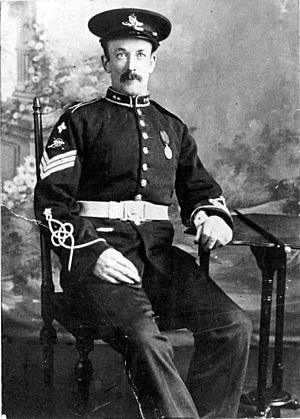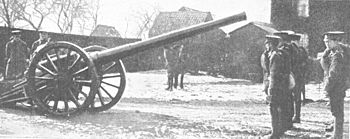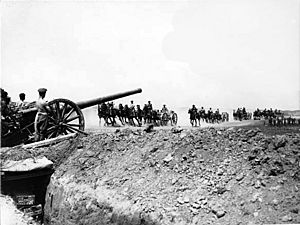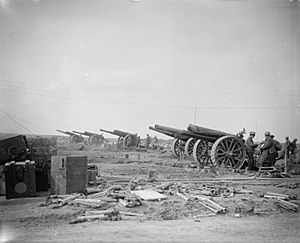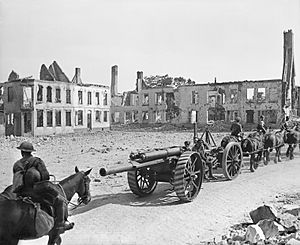1st Fife Artillery Volunteers facts for kids
Quick facts for kids 1st Fife Artillery VolunteersHighland (Fifeshire) Heavy Battery 56th (Highland) Medium Regiment 356th (Highland) Medium Regiment |
|
|---|---|
| Active | 1860–1967 |
| Country | |
| Branch | |
| Type | Artillery Regiment |
| Role | Garrison Artillery (1860–1908) Heavy Artillery (1908–1920) Medium Artillery (1920–1956) Field Engineers (1956–1967) |
| Engagements | First World War: Western Front Second World War: Battle of France Dunkirk evacuation Normandy |
| Commanders | |
| Notable commanders |
Sir Sidney Kirkman |
The 1st Fife Artillery Volunteers was a special army group. It started in Fife, Scotland, in 1860. This group, later known as the Highland (Fifeshire) Heavy Battery, fought bravely in the First World War. They were on the Western Front. Later, their new groups expanded to Aberdeenshire. They also fought in North West Europe during the Second World War.
Contents
Early Days: The Volunteer Force (1859–1908)
The Volunteer Force began in 1859. People were worried about a possible invasion. So, many joined local volunteer groups. These groups included Rifle, Artillery, and Engineer Corps.
By 1860, there were 11 Artillery Volunteer Corps (AVCs) in Fifeshire. Most were in towns along the coast:
- 1st (Tayport) Fife Artillery Volunteers, formed on 26 January 1860
- 2nd (Newport) Fife Artillery Volunteers, formed on 13 April 1860
- 3rd (St Andrews) Fife Artillery Volunteers, formed on 6 March 1860
- 4th (Inverkeithing) Fife Artillery Volunteers, formed on 3 March 1860
- 5th (Kirkcaldy) Fife Artillery Volunteers, formed on 22 March 1860
- 6th (Burntisland) Fife Artillery Volunteers, formed on 20 February 1860
- 7th (Anstruther) Fife Artillery Volunteers, formed on 8 March 1860
- 8th (Leven) Fife Artillery Volunteers, formed two batteries on 24 July 1860
- 9th (Dysart) Fife Artillery Volunteers, formed on 19 September 1860
- 10th (Wemyss) Fife Artillery Volunteers, formed on 16 January 1862
- 11th (Kinghorn) Fife Artillery Volunteers, formed on 30 April 1863
These groups formed the 1st Fifeshire Administrative Brigade. It was based in St Andrews. Lt-Col W.H.M. Dougall, a Royal Navy officer, led them. This brigade also included two units from Stirlingshire. They kept this structure for many years.
In 1881, the groups combined to become the 1st Fifeshire Artillery Volunteers. They covered Fifeshire and Stirlingshire. In 1882, all volunteer artillery units joined the Royal Artillery (RA). This unit became part of the Scottish Division. Later, it moved to the Southern Division.
In 1889, the Corps received 16-Pounder Rifled Muzzle Loading (RML) guns. These were powerful cannons. A new 14th Company was formed in Kirkaldy in 1900.
In 1899, the Artillery Volunteers joined the Royal Garrison Artillery (RGA). On 1 January 1902, the unit was renamed the 1st Fifeshire RGA (Volunteers). There was also a Cadet Corps for young people at Kirkcaldy High School.
Becoming the Territorial Force
In 1908, the Volunteer Force changed. It became the new Territorial Force (TF). The 1st Fifeshire RGA (V) was split into three parts. One part became the Highland (Fifeshire) RGA. This unit had a heavy battery with 4.7-inch guns. It also had an ammunition column. They were based in Kirkcaldy, then later in Dunfermline. This unit was part of the Highland Division of the TF. Major Lord Bruce led them from 1908 until 1914.
World War I: Fighting on the Western Front
1/1st Highland (Fifeshire) Battery
The Highland (Fifeshire) Heavy Battery got ready for war in Dunfermline. They joined the Highland Division. This division was training near Bedford. Soldiers who were fit for overseas service formed '1st Line' units. They trained to go abroad. The Highland Division later became the 51st (Highland) Division.
Battle of Aubers Ridge
The 1/1st Highland Battery went to France in May 1915. They joined the British Expeditionary Force (BEF). This was on the Western Front. The BEF decided to group heavy artillery batteries together. So, the battery joined II Group, Heavy Artillery Reserve. This group supported the attack at the Battle of Aubers Ridge. Their job was to destroy enemy strongpoints and fire at German guns.
The attack began on 9 May. Reports showed that many shells were falling short. This was because of bad ammunition and worn-out gun barrels. German guns fired back at the British trenches. These trenches quickly filled with wounded soldiers. A second attack later that day was hard because there wasn't enough artillery ammunition.
Fighting on the Somme
In April 1916, the heavy artillery groups were renamed HAGs. The battery moved to 1st HAG on 14 June. This group was with Fourth Army. They were getting ready for the big attack known as the Battle of the Somme. During this battle, the battery moved between different HAGs. After the Somme fighting ended, the 1/1st Highland Heavy Battery moved to 32nd HAG in December.
New Guns and New Battles
On 10 December 1916, the battery took a break. They replaced their 4.7-inch guns with more powerful 60-pounders. On 23 January 1917, they got more soldiers and guns from another battery. This made them a six-gun unit. They returned to fighting on 29 January. They moved to different HAGs and then joined XVII Corps in Third Army. This corps was getting ready for the Battle of Arras.
Battle of Arras
Many more guns were used in this attack. The plan for the artillery was much better. First, they fired at German artillery to stop them. Then, at the start of the attack, howitzers fired a constant barrage on German trenches. The 60-pounders fired deeper to hit machine gunners and moving soldiers.
The attack was very successful for XVII Corps. The 60-pounders kept firing until the infantry reached their goals. But moving the guns forward through mud was difficult. The fighting at Arras continued into May.
Battles in Flanders
The 1/1st Highland Heavy Battery moved to different HAGs throughout 1917. They were in Flanders, where the Ypres offensive was happening. This offensive included battles like Menin Road, Polygon Wood, and Broodseinde. These battles were successful because of the huge number of guns used.
But as the fighting continued, British guns became easy targets. They were visible from Passchendaele Ridge. Their own guns also sank into the mud, making them hard to use. The battery moved to a quieter area near Arras in October.
In the winter of 1917–18, the HAGs became permanent brigades. The 83rd HAG became 83rd Brigade, RGA. It was a 'Mixed' brigade with 60-pounders and other guns. The 1/1st Highland Heavy Battery stayed with 83rd Brigade until the end of the war.
German Spring Offensive
The Allies expected a big German attack. The 83rd Brigade's gun positions on Vimy Ridge were ready for defense. These positions, including the 1/1st Highland Battery's guns, were often shelled.
The German Spring offensive began on 28 March. The 83rd Brigade moved its most forward guns back. This helped them avoid much of the German shelling. British heavy artillery fired back strongly. But the 1/1st Highland Battery's two guns on Vimy Ridge were soon damaged. The gunners joined other batteries to keep firing.
The British heavy guns caught many German soldiers advancing. Even though they had many casualties, the British held their ground. The Germans did not attack again in the following days. The 1/1st Highland Battery had one soldier killed and eight wounded.
The Hundred Days Offensive
On 1 August, the heavy batteries moved. By 7 August, the 83rd Brigade was in the Somme area. They joined Fourth Army for the successful Hundred Days Offensive of 1918.
Fourth Army launched the Battle of Amiens on 8 August. All the guns of 83rd Brigade supported the attack. The attack was so successful that the enemy was soon out of range. The brigade was kept in reserve. The next day, the 60-pounders fired to support another attack.
The brigade continued to support attacks. They moved forward with the French army. By the end of August, the 60-pounder batteries were moving forward quickly. They kept up with the German withdrawal.
On 14 September, 83rd Brigade rejoined Fourth Army. They took part in the Battle of Épehy. The British artillery crushed a German counter-attack. The guns continued to fire at enemy positions. On 27 September, they fired heavily at German roads and headquarters. This was as Fourth Army approached the Hindenburg Line.
On 29 September, IX Corps crossed the St Quentin Canal. The 83rd Brigade was among the many guns supporting this. The heavy guns had destroyed the canal defenses. The British soldiers crossed the canal in the morning mist. The 83rd Brigade moved forward to new positions along the canal. The lighter guns, including 1/1st Highland Battery, worked directly with the 46th (North Midland) Division.
By 3 October, the brigade supported IX Corps' attack on the Beaurevoir Line. Fourth Army then chased the Germans to the River Selle. The 60-pounders kept up with the advance. From 11 to 17 October, Fourth Army prepared for another attack. The 83rd Brigade supported IX Corps.
The attack on 17 October (the Battle of the Selle) was successful. Another attack followed on 23 October. The guns of Fourth Army were very effective. They "simply swept away the opposition."
By now, the 83rd Brigade had left its heavier guns behind. On 27 October, the 60-pounder gunners rested. They returned to the front on 4 November. Fourth Army crossed the Sambre Canal (the Battle of the Sambre) with huge fire support. The 60-pounder batteries crossed the canal on 6 November. They fired at extreme range as the advance became a chase. On 10 November, the guns were ready until the Armistice with Germany began the next day.
After the war, 83rd Brigade was chosen to be part of the Army of Occupation in Germany. They went to Belgium for the winter. Soldiers began to go home in January 1919.
2/1st Highland (Fifeshire) Battery
After the war started, a '2nd Line' unit was formed. This was for soldiers who stayed home or were new volunteers. Their job was to defend Britain and train new soldiers. The 2/1st Highland (Fifeshire) Heavy Battery RGA was formed in Dunfermline. It was part of the 64th (2nd Highland) Division. In January 1916, the division moved to Norfolk. In September 1916, the battery left 64th Division. It kept its older 4.7-inch guns. It stayed with this brigade until the end of the war.
Between the World Wars
When the Territorial Force was reformed in 1920, the battery became the 1st (Highland) Medium Brigade, RGA. Its headquarters moved to Aberdeen. It included soldiers from the old Highland (Fifeshire) Battery and other units. It was renamed the 5th (Highland) Medium Brigade in 1921. In 1924, the RGA joined the RA.
By 1927, the unit was called the 56th (Highland) Medium Brigade, RA (TA). It had four batteries:
- HQ at Aberdeen
- 221st (Peterhead) Medium Battery
- 222nd (Fraserburgh) Medium Battery
- 223rd (Banffshire) Medium Battery
- 224th (Fife) Medium Battery
In 1938, the 224th (Fife) Battery moved to form a new anti-aircraft unit. Another battery, 174th, joined the regiment. On 1 November 1938, RA brigades were renamed regiments. So, by 1939, the unit was the 56th (Highland) Medium Regiment, RA (TA).
Before World War II began in September 1939, the regiment split into two. The 56th Medium Regiment kept two batteries. A new 65th Medium Regiment was formed with the other two. Both were part of the Highland Area.
World War II: New Battles
56th (Highland) Medium Regiment
The regiment went to France in October 1939. It was part of the British Expeditionary Force.
When the Battle of France started on 10 May 1940, the regiment moved into Belgium. Then they had to retreat to Dunkirk. There, they had to destroy their guns and wait to be evacuated (Operation Dynamo).
After Dunkirk, the regiment became part of Home Forces. They were sent to defend Essex. They had a mix of old and new guns. The guns had to cover a very long coast.
The Essex coastal defenses were stood down in 1941. The units returned to training. The 56th Medium Regiment did not see active fighting again. In 1943, it became a reserve regiment. It stayed with reserve divisions until the end of the war.
In early 1945, the regiment changed again. It was finally put into 'suspended animation' (meaning it stopped existing for a while) in May 1946.
65th (Highland) Medium Regiment
When this regiment started in September 1939, its howitzers still had wooden wheels. They were from the days when horses pulled them. This regiment also went to France and lost its guns. After Dunkirk, it became part of Home Forces. It was allowed to use the 'Highland' name in 1942.
In May 1944, the regiment joined Second Army. They were getting ready for Operation Overlord, the invasion of Normandy. The regiment landed on 8 June. They provided fire support to other divisions.
The regiment continued to serve in North West Europe until the war ended. The 65th Medium Regiment was put into suspended animation on 4 February 1946.
After the Wars
When the Territorial Army was reformed in 1947, the 56th Regiment was brought back. It was called 356 (Highland) Medium Regiment, RA. The 65th Regiment was officially disbanded.
On 31 October 1956, the 356 Regiment changed. It became 278th (Buchan & Banff Artillery) Field Squadron, part of the Royal Engineers. In 1961, the squadron was assigned to the 51st (Highland) Division. However, it was disbanded in 1967.
Honorary Colonels
These people served as Honorary Colonel for the 1st Fife Artillery and its later groups:
- W.H.M. Dougall, RN, from 1872
- S. Grace, VD, from 1890
- 9th Earl of Elgin and Kincardine, KG, GCSI, GCIE, from 1902
- Col A.W. McPherson, from 1935 (for 56th (Highland) Medium Regiment)


